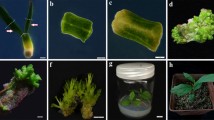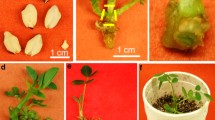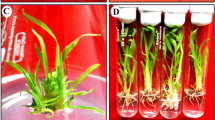Summary
Multiple shoots were produced, from cotyledonary node explants of pea (Pisum sativum L.) cultured on MS medium containing 1 mg 1−1 BAP. The number of buds formed could be increased by scraping the nodes before culture or by increasing the cytokinin concentation. However, cytokinin levels over 5 mg 1−1 increasingly produced shoots that were vitrified and dificult to root. With all the genotypes tested, developing buds were visibile as soon as 5 days after culture and elongated shoots could be removed after 21 days., Histological studies indicated, that the buds and shoots were formed from superficial layers of tissue. The efficiency of this regeneration system compared favorably with previosly published methods. The rapid, genotype-independent, high frequency system described here may be of use in the production of transgenic pea plants.
Similar content being viewed by others
References
Cheng, T-Y.; Saka, H.; Voqui-Dinh, t. H. Plant regeneration from soybean cotyledonary node segments in culture. Plant Sci. Lett. 19:91–99; 1980.
Gamborg, O. L.; Constabel, F.; Shyluk, J. P. Organogenesis in callus from shoot apices ofPisum sativum. Physiol. Plant. 30:125–128; 1974.
Gamborg, O. L.; Miller, R. A.; Ojima, K. Nutient requirements of suspension cultures of soybean root cells. Exper. Cell Res. 50:151–158; 1968.
Hoagland, D. R.; Arnon, D. I. The water-culte method for growting plants without soil. Circular 347, University of California, College of Agriculture. Berkeley, California; 1938.
Hobbs, S. L. A.; Jackso, J. A.; Mahon, J. D. Specificity of strain and genotype, in the sus ceptibility of pea toAgrobacterium tumefaciens. Plant Cell Rep. 8:274–277; 1989.
Hussey, G.; Gunn, H. V. Plant production in pea (Pisum sativum L. cvs. Puget and Upton) from long-term callus with superficial meristems. Plant Sci. Lett. 37:143–148; 1984.
Hussey, G.; Johnson, R. D.; Warren, S. Transformation of meristematic cells in the shoot apex of cultured pea shoots byAgrobacterium tumefaciens andA. rhizogenes. Protoplasma 148:101–105; 1989.
Kartha, K. K.; Gamborg, O. L.; Constabel, F. Regeneration of pea (Pisum sativum L.) plants from shoot apical meristems. Z. Pflanzenphysiol. 72:172–176; 1974.
Kysely, W.; Myers, J. R.; Lazzeri, P. A., et al. Plant regeneration via somatic embryogenesis, in pea (Pisum sativum L.). Plant Cell Rep. 6:305–308; 1987.
Lehminger-Mertens, R.; Jacobsen, H.-J. Protoplast regeneration and organogenesis from pea protoplasts. In Vitro Cell. Dev. Biol. 25:571–574; 1989.
Malmberg, R. L. Regeneration of whole plants from callus culture of diverse genetic lines ofPisum sativum. Planta 146:243–244; 1979.
McClean, P.; Grafton, K. F. Regeneration of dry bean (Phaseolus vulgaris L.) via organeogenesis. Plant Sci. 60:117–122; 1989.
Mroginski, L. A.; Kartha, K. K. Regeneration of pea (Pisum sativum L. cv. Century) plants by in vitro culture of immature leaflets. Plant Cell Rep. 1:64–66; 1981.
Murashige, T.; Skoog, F. A revised medium for rapid growth and bioassays with tobacco tissue cultures. Physiol. Plant. 15:473–497; 1962.
Puonti-Kaerlas, J.; Eriksson, T. Improved protoplast culture and regenration of shoots in pea (Pisum sativum L.). Plant Cell Rep. 7:242–245; 1988.
Puonti-Kaerlas, J.; Stabel, P.; Eriksson, T. Transformation of pea (Pisum sativum L.) byAgrobacterium tumefaciens. Plant Cell Rep. 8:321–324; 1989.
Rubluo, A.; Kartha, K. K.; Mroginski, L. A., t al. Plant regeneration from pea leaflets cultured in vitro and genetic stability of regenerants. J. Plant Physiol. 117:119–130; 1984.
Wright, M. S.; Koehler, S. M.; Hinchee, M. A., et al. Plant regeneration by organogenesis inGlycine max. Plant Cell Rep. 5:150–154; 1986.
Author information
Authors and Affiliations
Rights and permissions
About this article
Cite this article
Jackson, J.A., Hobbs, S.L.A. Rapid multiple shoot production from cotyledonary node explants of pea (Pisum sativum L.). In Vitro Cell Dev Biol 26, 835–838 (1990). https://doi.org/10.1007/BF02623626
Received:
Accepted:
Issue Date:
DOI: https://doi.org/10.1007/BF02623626




